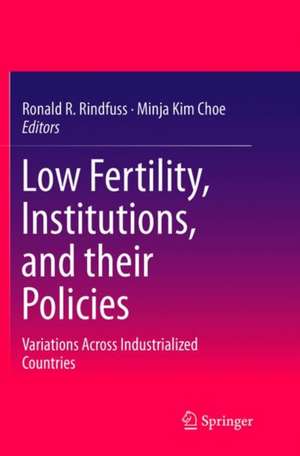Low Fertility, Institutions, and their Policies: Variations Across Industrialized Countries
Editat de Ronald R. Rindfuss, Minja Kim Choeen Limba Engleză Paperback – 31 mai 2018
The countries examined are not only diverse geographically, historically, and culturally, but also have different policies and institutions in place. They include six very-low-fertility countries (Austria, Czech Republic, Hungary, Italy, Spain, and Taiwan) and four that have close to replacement-level fertility (United Kingdom, Norway, Canada, and France).
Although fertility has gone down in all these countries over the past 50 years, the chapters examine the institutional, policy, and cultural factors that have led some countries to have much lower fertility rates than others. In addition, the final chapter provides a cross-country comparison of individual perceptions about obs
tacles to fertility, based on survey data, and government support for families. This broad overview, along with a general introduction, helps put the specific country papers in context. As birth rates continue to decline, there is increasing concern about the fate of social welfare systems, including healthcare and programs for the elderly. This book will help readers to better understand the root causes of such problems with its insightful discussion on how a country’s institutions, policies, and culture shape fertility trends and levels.
| Toate formatele și edițiile | Preț | Express |
|---|---|---|
| Paperback (1) | 508.43 lei 39-44 zile | |
| Springer International Publishing – 31 mai 2018 | 508.43 lei 39-44 zile | |
| Hardback (1) | 791.88 lei 3-5 săpt. | |
| Springer International Publishing – 28 iun 2016 | 791.88 lei 3-5 săpt. |
Preț: 508.43 lei
Preț vechi: 635.53 lei
-20% Nou
Puncte Express: 763
Preț estimativ în valută:
97.29€ • 106.01$ • 81.98£
97.29€ • 106.01$ • 81.98£
Carte tipărită la comandă
Livrare economică 21-26 aprilie
Preluare comenzi: 021 569.72.76
Specificații
ISBN-13: 9783319814179
ISBN-10: 3319814176
Pagini: 303
Ilustrații: VIII, 303 p. 62 illus. in color.
Dimensiuni: 155 x 235 mm
Ediția:Softcover reprint of the original 1st ed. 2016
Editura: Springer International Publishing
Colecția Springer
Locul publicării:Cham, Switzerland
ISBN-10: 3319814176
Pagini: 303
Ilustrații: VIII, 303 p. 62 illus. in color.
Dimensiuni: 155 x 235 mm
Ediția:Softcover reprint of the original 1st ed. 2016
Editura: Springer International Publishing
Colecția Springer
Locul publicării:Cham, Switzerland
Cuprins
Diverse Paths to Low and Lower Fertility: An Overview.- Not so Low Fertility in Norway—A Result of Affluence, Liberal Values, Gender-Equality Ideals, and the Welfare State.- The Influence of Family Policies on Fertility in France: Lessons From the Past and Prospects for the Future.- Fertility and Population Change in the United Kingdom.- Canadian Fertility Trends and Policies: A Story of Regional Variation.- The European Middle way? Low Fertility, Family Change, and Gradual Policy Adjustments in Austria and the Czech Republic.- Fertility Decline and the Persistence of Low Fertility in a Changing Policy Environment—A Hungarian Case Study.- The Policy Context of Fertility in Spain: Toward a Gender-Egalitarian Model?.- Aging Italy: Low Fertility and Societal Rigidities.- Transition From Anti-natalist to Pro-natalist Policies in Taiwan.- Governmental Support for Families and Obstacles to Fertility in East Asia and Other Industrialized Regions.
Recenzii
“Each chapter is written by a country expert who presents recent fertility trends and discusses the social, economic, institutional, historical, and cultural factors affecting fertility as well as policies. … an invaluable resource for students, researchers, and policymakers, providing comprehensive and highly informative expositions of the causes of low fertility in high income countries.” (Population and Development Review, Vol. 43 (1), March, 2017)
Notă biografică
Ronald R. Rindfuss is a Research Professor in the Department of Sociology, Adjunct Professor in the Geography Department, and a Fellow of the Carolina Population Center at the University of North Carolina – Chapel Hill, and a Senior Fellow at the East-West Center, Honolulu, HI. He is Past President of the Population Association of America and a former Director of the Carolina Population Center. His research interests include fertility, population and the environment, migration and family demography.
Minja Kim Choe is an Adjunct Senior Fellow at East-West Center’s Research Program. Her research interests include family change, low fertility and population aging, and statistical analyses of demographic processes.
Textul de pe ultima copertă
This volume examines ten economically advanced countries in Europe and Asia that have experienced different levels of fertility decline. It offers readers a cross-country perspective on the causes and consequences of low birth rates and the different policy responses to this worrying trend.
The countries examined are not only diverse geographically, historically, and culturally, but also have different policies and institutions in place. They include six very-low-fertility countries (Austria, Czech Republic, Hungary, Italy, Spain, and Taiwan) and four that have close to replacement-level fertility (United Kingdom, Norway, Canada, and France).
Although fertility has gone down in all these countries over the past 50 years, the chapters examine the institutional, policy, and cultural factors that have led some countries to have much lower fertility rates than others. In addition, the final chapter provides a cross-country comparison of individual perceptions about obs
tacles to fertility, based on survey data, and government support for families. This broad overview, along with a general introduction, helps put the specific country papers in context. As birth rates continue to decline, there is increasing concern about the fate of social welfare systems, including healthcare and programs for the elderly. This book will help readers to better understand the root causes of such problems with its insightful discussion on how a country’s institutions, policies, and culture shape fertility trends and levels.
The countries examined are not only diverse geographically, historically, and culturally, but also have different policies and institutions in place. They include six very-low-fertility countries (Austria, Czech Republic, Hungary, Italy, Spain, and Taiwan) and four that have close to replacement-level fertility (United Kingdom, Norway, Canada, and France).
Although fertility has gone down in all these countries over the past 50 years, the chapters examine the institutional, policy, and cultural factors that have led some countries to have much lower fertility rates than others. In addition, the final chapter provides a cross-country comparison of individual perceptions about obs
tacles to fertility, based on survey data, and government support for families. This broad overview, along with a general introduction, helps put the specific country papers in context. As birth rates continue to decline, there is increasing concern about the fate of social welfare systems, including healthcare and programs for the elderly. This book will help readers to better understand the root causes of such problems with its insightful discussion on how a country’s institutions, policies, and culture shape fertility trends and levels.
Caracteristici
Compares fertility trends and levels across 10 economically advanced countries in Europe and Asia Describes how these countries’ institutions, culture, and history shape fertility levels and patterns Examines existing government policies that may affect fertility, either intentionally or inadvertently, as well as public opinion about policy measures that might affect fertility Includes supplementary material: sn.pub/extras













